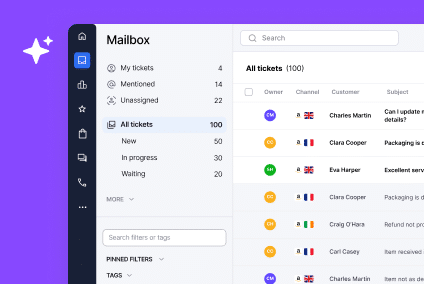If you sell on both Amazon and eBay, you know the feeling. A customer message comes in. You reach for your standard response template. Then you pause. Is this the Amazon version or the eBay version? Can I say this here? Will it violate their policies?
The truth is that Amazon and eBay operate under completely different customer service rules. What works on one platform can get you suspended on the other. Response times differ. Message policies vary. Escalation processes are entirely separate. For multichannel sellers, virtual assistants, and brand managers juggling both marketplaces, these differences aren’t just annoying quirks. They can directly impact your seller rating, account health, and ultimately your revenue.
This guide breaks down exactly how Amazon and eBay customer support requirements differ, so you spend less time guessing and more time selling.
Response Time SLAs: Amazon vs eBay
Amazon’s SLA is strict and unforgiving. You have 24 calendar hours to respond to every buyer message. Not business hours. Calendar hours. That means your 24-hour window counts weekends, holidays, and 3 AM on a Tuesday the same as any other time.
Miss that deadline? Your Order Defect Rate (ODR) takes a hit. Fall below 1% and Amazon starts restricting your ability to list new products. Push higher and you risk suspension. The stakes are high because the enforcement is automated.
eBay’s approach feels almost relaxed by comparison. They ask for a response within 24 to 48 hours. The timing is looser. eBay doesn’t immediately penalize missed messages the way Amazon does through a hard metric like ODR. However, response time does factor into your seller rating indirectly. Buyers leave feedback based on how quickly you engage with their questions. Slow responses lead to lower ratings, which then affects visibility in search results.
How the SLAs Compare in Practice
| Platform | SLA Requirement | Enforcement Method |
| Amazon | 24 calendar hours (7 days a week) | Automated via Order Defect Rate (ODR) |
| eBay | 24-48 hours | Indirect via seller rating and buyer feedback |
Amazon Example: One missed message at 2 PM on a Saturday counts against your ODR immediately. There’s no category for urgent versus routine. Everything gets the same 24-hour deadline.
eBay Example: You can prioritize your high-value messages without the same automated penalty. A response at 36 hours might not get flagged by the platform, though it could still influence buyer sentiment.
For teams using tools like eDesk, SLA tracking becomes essential. eDesk’s unified inbox lets you set separate SLA timers for Amazon and eBay so your team knows which deadline is which. When managing agent-SLA tracking across multichannel operations, precision matters.
The core difference remains: Amazon demands precision. eBay allows breathing room.
Buyer Messaging Rules: What You Can and Can’t Say
This is where the policy divergence gets real.
Amazon’s Strict Messaging Policy
Amazon’s messaging policy is built on a specific principle: the Message Center exists to facilitate transactions, not to build relationships or market to buyers. Amazon’s guidelines are explicit about what you cannot do:
- No promotional content. You cannot use the Message Center to advertise other products or services. No « Check out our store » or « Browse our other listings » language.
- No links. External URLs are not allowed. If a buyer asks for product information, you cannot link them to your website or social media. You must explain everything within the message itself.
- No upselling or cross-selling. You cannot recommend alternatives or suggest related products. Stick to the transaction at hand.
- Only approved message types. Amazon categorizes interactions: shipping updates, delivery issues, return questions, and problem resolution. Marketing messages, even soft ones, violate policy.
The cost of violations is steep. Understanding Amazon’s messaging policy is foundational to maintaining account health. Account restrictions or suspension can destroy a selling business overnight.
eBay’s More Flexible Approach
eBay’s messaging policy is more permissive. You have more room to clarify listing details, answer pre-sale questions conversationally, and even mention related items in your store if it’s relevant to the buyer’s inquiry. The tone can be friendlier. You’re not locked into a rigid format. However, you still cannot spam, misrepresent products, or send unsolicited marketing.
Side-by-Side Message Examples
Amazon Message: « Your order will arrive on December 15. If you have any other questions about this specific item, please reply here. »
eBay Message: « Your order will arrive on December 15. We have similar styles in stock if you’d like to check them out. Feel free to message me anytime. »
The second message would violate Amazon policy. On eBay, it’s perfectly acceptable and actually encouraged.
For sellers managing both platforms, the mental shift is significant. Amazon requires you to compartmentalize. Each message is a transaction. eBay allows a relationship. Teams using templates and macros need to maintain separate versions for each platform.
Returns, Refunds, and Case Management
The refund and returns process is fundamentally different between the two platforms, which directly affects your customer service workflow.
Amazon’s Return Process and Seller Control
On Amazon, if you’re Fulfillment by Amazon (FBA), Amazon handles returns entirely. The buyer ships the item back to Amazon’s warehouse. Amazon inspects it and processes the refund. Your customer service team gets minimal involvement. For Merchant Fulfilled orders, you handle returns directly, but Amazon sets the framework. You cannot refuse a return within Amazon’s return window without facing account penalties. If a buyer opens an A-to-Z claim, Amazon investigates and almost always sides with the buyer unless you have strong evidence. Amazon’s automated system doesn’t require much negotiation.
Understanding the nuances of FBA returns versus Merchant Fulfilled returns is critical for account health. The difference in control and liability can significantly impact profitability.
eBay’s Seller-Centric Return Model
eBay takes a different approach. The seller typically manages the entire return process. If a buyer wants to return an item, you coordinate with them directly. You set the terms. Do you require the item in original condition? What about return shipping costs? These are your decisions. eBay provides a framework for Resolution Center cases, but the interaction is more direct. You message the buyer, agree on terms, receive the return, and process the refund. eBay intervenes if the case remains unresolved after a certain period, but the default is seller-buyer negotiation.
Customer Service Approach by Platform
Amazon: Focus on prevention. Accurate descriptions and clear images reduce returns before they happen. Respond quickly to pre-purchase questions to avoid post-purchase dissatisfaction. For FBA returns, your role is minimal. For Merchant Fulfilled returns, prepare detailed policies and ship replacements quickly if needed.
eBay: Build relationships with buyers. Be willing to negotiate. Offering partial refunds, replacements, or accepting returns outside your stated window often prevents negative feedback and Resolution Center escalations. Your customer service team has more autonomy here.
The difference in return management philosophy reflects each platform’s business model. Amazon emphasizes buyer protection and satisfaction. eBay emphasizes seller autonomy and negotiation. Your policies and training must align with each platform’s reality.
Platform-Specific Customer Service Tools
Not all tools work equally on both platforms. If you’re selling on Amazon and eBay, your helpdesk software choice matters significantly.
eDesk: Full Multichannel Integration
eDesk offers full integration with both Amazon and eBay. Your unified inbox shows all buyer messages from both platforms in one place. You can set separate SLA timers. You can tag messages by platform so your team applies the right policies. SLA tracking works across both marketplaces. For sellers managing high volumes on both platforms, this reduces errors and accelerates response times.
ChannelReply: Message Automation
ChannelReply integrates with both Amazon and eBay through API connections. It specializes in buyer message automation. You set up rules, and ChannelReply automatically sends responses to common questions. On Amazon, this helps you meet the 24-hour SLA for routine inquiries. On eBay, it keeps your response times competitive.
3Dsellers: eBay-Focused Solution
3Dsellers focuses primarily on eBay. It offers extensive macro and template libraries designed specifically for eBay’s policies and workflows. If you’re heavy on eBay with light Amazon activity, 3Dsellers provides depth in one channel. For truly multichannel operations, it’s less useful.
Tool Comparison Summary
| Tool | Amazon Integration | eBay Integration | Best For |
| eDesk | Full | Full | Balanced multichannel sellers |
| ChannelReply | Full (via API) | Full (via API) | Automation-focused teams |
| 3Dsellers | No | Full | eBay-dominant sellers |
Here’s the practical reality: if you’re splitting your effort between Amazon and eBay equally, a tool designed specifically for multichannel support saves hours every week. You eliminate context switching. Your team applies consistent processes. Your data lives in one place, making reporting and performance analysis easier.
Building a Multichannel CX Strategy
Selling on both platforms means your customer service playbook needs two chapters, not one universal guide.
Create Platform-Specific Templates
Don’t copy-paste your response templates across platforms. Amazon’s strict policies require formal, transactional language. eBay’s more relaxed environment allows personality. A template that works on one platform violates policy on the other. Build separate templates for each marketplace. Test them. Refine them based on buyer feedback and response rates.
Train Your Team on Platform Differences
This isn’t obvious. A virtual assistant accustomed to Amazon’s rigid rules might violate eBay policy by trying to follow Amazon’s strict format. Conversely, an eBay-focused team member might get an Amazon account suspended by adding promotional language that’s perfectly fine on eBay. Invest in platform-specific onboarding. Run drills. Use real examples from your own account.
Implement Unified Helpdesk Tools
Sync your SLAs and visibility through a unified helpdesk when possible. Manual tracking across separate systems creates gaps. Someone misses a message on eBay because they were focused on Amazon. A customer service incident on one platform affects metrics you’re tracking on another. A tool like eDesk that handles both platforms simultaneously prevents these gaps.
Establish Platform-Specific Escalation Procedures
Amazon’s A-to-Z claims follow Amazon’s process. eBay’s Resolution Center cases follow eBay’s process. Your team needs to know the difference. Amazon escalations are faster and favor the buyer more often. eBay escalations require more evidence of your seller standing. Train your team accordingly.
Monitor Metrics Separately
Your Amazon Order Defect Rate is a hard number. It directly impacts your account health. eBay’s seller rating is more of a reputation score. Both matter, but they measure different things. Track them separately. Celebrate improvements on each platform independently. Sometimes optimizing for one marketplace means accepting slightly different performance on the other.
Final Thoughts
Amazon and eBay require different approaches to customer service. Not because one is better or worse, but because they operate under fundamentally different business models. Amazon owns the customer relationship. eBay facilitates the seller-buyer relationship. That difference cascades through everything from message policies to SLA enforcement to return management and customer experience optimization.
For multichannel sellers, virtual assistants, and brand managers, the path forward is clear. Understand the platform differences. Use tools designed for multichannel support. Train your team on platform-specific policies. Track metrics separately. Build processes that respect each marketplace’s unique requirements.
When you get these details right, you protect your account health, reduce customer complaints, and free up your team to focus on growing your business instead of managing policy violations. The real win happens when your team stops worrying about which policy applies to which message and starts focusing on delighting customers across both platforms. Managing Amazon and eBay support doesn’t have to be complicated if you have the right foundation in place and the right tools supporting you.
Ready to simplify multichannel support? Stop juggling separate systems for Amazon and eBay. Create your free eDesk account and manage both platforms from one unified inbox with separate SLA tracking, platform-specific templates, and real-time visibility into your response times.
FAQs
What’s the difference between Amazon and eBay customer support requirements?
Amazon enforces strict 24-hour calendar day response times tracked through Order Defect Rate (ODR), while eBay allows 24-48 hours with less automated enforcement. Amazon prohibits marketing and external links in buyer messages; eBay allows more conversational engagement. Amazon restricts seller control over returns; eBay gives sellers more autonomy in managing returns and negotiations.
Can I use the same response templates for both platforms?
No. Amazon requires formal, transactional language and prohibits promotional content or external links. eBay allows friendlier, more relationship-focused communication. Using Amazon-style templates on eBay misses engagement opportunities. Using eBay-style templates on Amazon risks policy violations and account restrictions. Maintain separate template libraries for each platform.
What happens if I miss a message deadline on Amazon versus eBay?
On Amazon, missing a 24-hour response deadline immediately counts against your Order Defect Rate (ODR). Repeated violations drop your ODR below 1% and trigger account restrictions or suspension. On eBay, a missed 24-48 hour response doesn’t trigger an automated penalty, but slow response times indirectly affect your seller rating through buyer feedback, which impacts search visibility.
Which tools help manage Amazon and eBay support together?
eDesk offers full integration with both platforms in a unified inbox with separate SLA timers. ChannelReply provides buyer message automation for both marketplaces. 3Dsellers focuses primarily on eBay. For balanced multichannel operations, eDesk is specifically designed for managing both platforms from one dashboard.
How do Amazon and eBay handle returns differently?
Amazon handles FBA returns through its own warehouse and process. For Merchant Fulfilled orders, Amazon’s automated system heavily favors the buyer in A-to-Z claims. eBay places the seller at the center of return management. You negotiate directly with the buyer through Resolution Center. eBay intervenes only if negotiation fails. This means your customer service approach must be different on each platform.
Does my seller rating on Amazon and eBay affect the same metrics?
No. Amazon tracks Order Defect Rate (ODR) as the primary account health metric. eBay tracks seller rating through buyer feedback. Excellent Amazon metrics do not improve your eBay rating, and vice versa. You need to monitor both separately and optimize for each platform’s specific requirements.
What should my response time target be for each platform?
On Amazon, your target must be under 24 hours to avoid ODR penalties. Most successful sellers aim for 18-20 hours to provide a safety buffer. On eBay, aim for under 24 hours to remain competitive with top-rated sellers. Response times within 12 hours significantly boost your seller rating and search visibility on both platforms.




